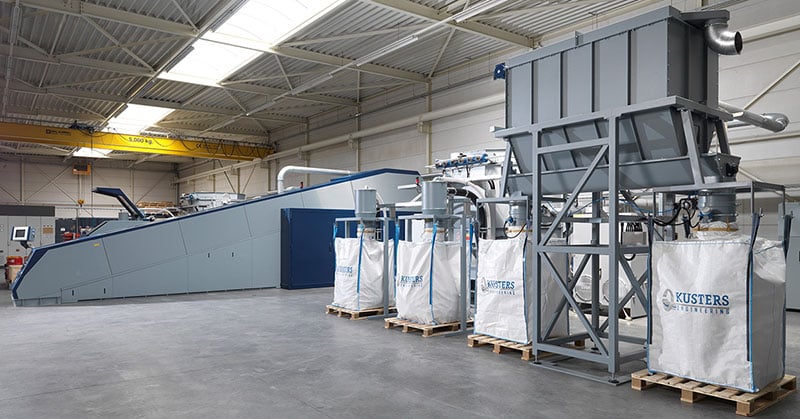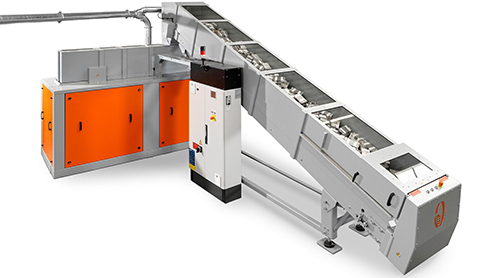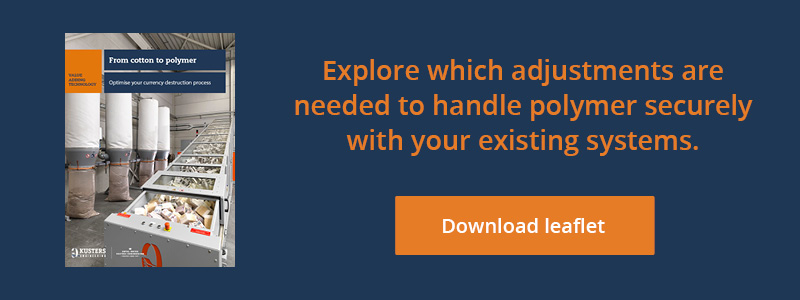
Since 1979, our banknote destruction systems can handle cotton, polymer, and hybrid banknotes. There is no exceptional design needed to deal with polymer shreds. Some minor changes to your current cotton-based banknote destruction systems will do.
Royal Dutch Kusters Engineering has proven in numerous places its currency destruction systems - formerly used to handle cotton banknotes - are working just as well with polymer banknotes or processing these simultaneously.
Overview of content
Required adjustments to the Currency Destruction Systems (CDS)
Recommended polymer shred collection units (SCU or OPCS)
Effortless simultaneous destruction of cotton and polymer banknotes
Required adjustments to the Currency Destruction Systems (CDS)
When a country chooses to switch to a polymer-based substrate for (certain) denominations, it has consequences for its banknote destruction process. Although these consequences are minor, it is important to be aware of them.
The Kusters CDS machines consist of five components: the loading conveyor, the pre-crusher (first-stage shredding), the granulator (second-stage shredding), an air transport fan and a noise-cancelling cabin.

Royal Dutch Kusters Engineering CDS V-Series
In general, only three adjustments* are required to optimise your current CDS for the destruction of polymer-based banknotes:
1. Different knife schedule of the pre-crusher
2. Different tuning of the pre-crusher and the granulator
3. The addition of ionization units
*Please note the mentioned changes depend on - but are not limited to - the systems’ version, software, age, and the available space in the building.
The granulator - used in the second stage of shredding - originates from granulating plastics, making it especially suited for polymer. When destroying polymer, it is, therefore, unnecessary to change the knives of the granulator as our one-pieces facilitate good heat transfer and easy cooling by air.
Nevertheless, to efficiently destroy polymer banknotes with your current system, the tuning with the pre-crusher has to be recalibrated. The pre-crusher prepares the right size of strips for the granulator for optimal destruction of the banknotes. Because polymer tends to release more heat during shredding than cotton, the desired output size of strips of polymer banknotes differs from those of cotton banknotes. That is why another knife schedule and tuning of the pre-crusher is required. In this way, optimal heat transfer of the granulator blades is assured.
Lastly, during the extraction of the polymer shreds from the pre-crusher towards the granulator, static electricity could arise, causing the polymer shreds to stick and jam the system. To resolve this issue, Royal Dutch Kusters Engineering places ionization units on evident places in the CDS system. These units will make the air act as a conductor of the static charge. In this way, the built-up static electricity on the polymer banknotes and shreds is neutralized.
![]()
Did you know... all Kusters CDS conveyors are equipped with an anti-static belt irrespective of the nature of the substrate?
Although more relevant with polymer-based substrates, static electricity could also occur when processing cotton and hybrid banknotes, causing the banknotes to stuck to the belt and pose security risks.
Recommended polymer shred collection units (SCU or OPCS)
For the collection of polymer shreds, reduction of size through briquetting is not possible due to the tendency of the polymer to heat up and melt accordingly.
However, Kusters has three other shred collection systems available, which have been used for years either as backup/emergency options or alternatives for our briquetting system. These systems can be added to your currency destruction process, or the capacity of your current collection systems can be upgraded.
-
- Shred Collection Unit (SCU)
The Kusters SCU systems collects the shreds in a closed unit with self-cleaning air filter to separate the dust from the shreds. A screw conveyor then distributes the shreds to the connected (big) bags at the output of the screw. This set-up allows a clean and safe operation. The filter contains anti-static filter bags to prevent the generation of static electricity. - Double Cyclonic Separator (DCS)
The Kusters DCS systems are designed as an emergency option and are straightforward collection bags. However, as the bags need to be replaced there will be dust involved.
- Shred Collection Unit (SCU)
-
- Online Polymer Collection System (OPCS)
The Kusters OPCS systems are a variation on the Online Briquetting Systems (OBS). This option is most favourable when an OBS is already present. The OBS can then be rebuilt to effectively collect the polymer shreds, separate the dust and transport the shreds into (big) bags or containers. The OPCS is also available as a multifunctional collection system to collect both polymer- and cotton shreds separate from each other.
- Online Polymer Collection System (OPCS)
Read more on the Kusters polymer shred collection systems in our Handling polymer banknotes; Reliable dust-free shred collection systems leaflet.

The Royal Dutch Kusters Engineering SCU, DCS and OPCS
Effortless simultaneous destruction of cotton and polymer banknotes
When adopting polymer substrates for (certain) denominations, a country will likely have cotton and polymer substrates in circulation simultaneously. The current systems will have to be upgraded to handle various substrates - also hybrids - simultaneously. The necessary adjustments will mainly depend on the customer's wishes, the current system (such as the version) and the opportunities of the building.
It is possible to mix up to 25% of polymer shreds with cotton shreds in an OBS. However, Kusters strongly advises against it as it makes proper recycling of the high-quality polymer shreds impossible.
It is recommendable to keep the shreds completely separate to be able to recycle the clean polymer shreds into high-quality raw material for high-quality polymer products and briquette the cotton shreds as usual.
Whether the polymer shreds will indeed be recycled strongly depends on local circumstances. Royal Dutch Kusters Engineering is, therefore, engaging in opportunities to stimulate the recycling of polymer banknote shreds.
Please subscribe below if you would like to receives updates on our polymer recycling initiatives:
Discover our currency destruction solutions
Royal Dutch Kusters Engineering is the world's leading manufacturer of currency destruction equipment. We design, develop, deliver, install and service reliable and secure destruction solutions for all types of banknotes.
If you want to know more about our upgrade solutions to handle polymer banknotes, please download our leaflet: 'From cotton to polymer'.
You can also request a free consult with our specialists to discuss the potential of your equipment to be upgraded to handle polymer.
Keep informed on the latest insights and subscribe to our blog.


